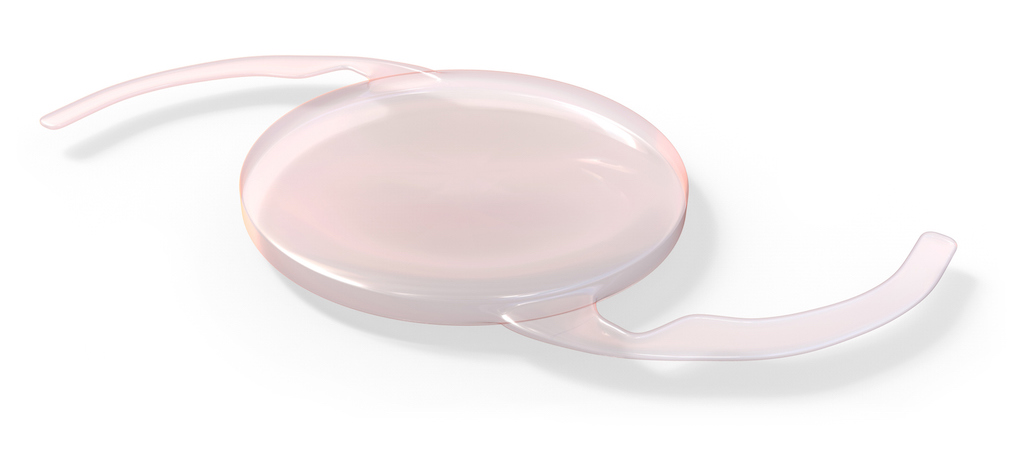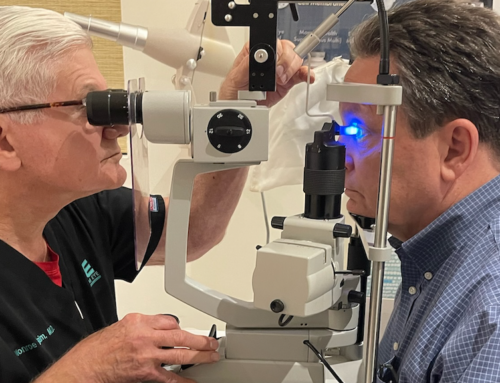
Cataracts can make your vision look cloudy, blurred or dim. This can make it difficult to do everyday activities, including reading or driving at night.
During cataract surgery, your eye’s natural lens is replaced with an intraocular lens (or IOL, for short). These lenses bend light rays as they enter your eye, which helps you to see more clearly.
Read on to understand why the eye’s natural lens might need to be replaced, how IOLs work and the best lenses to consider for cataract surgery.
Why does the eye’s natural lens need to be replaced?
Your eye’s natural lens gives your eyes the ability to focus. A cataract clouds that focusing power. A cataract forms when the proteins in your eye’s natural lens start to breakdown. When this occurs, the protein clumps together in the eye’s natural lens. Eventually, these protein clumps block light from entering the eye and hinder your vision.
In the early stages, you may be able to get by with increased lighting and prescription glasses. As it advances, though, it becomes like looking through a permanently foggy windshield or frosted glass.
Cataracts generally develop in both eyes, but not always at the same rate. That means one eye may have a more progressive cataract than the other. It does not “spread” from one eye to the other, as it’s not contagious. More so, if a person is susceptible to developing cataracts in one eye, they’ll also likely develop it in the other.
For this reason, patients may opt to have both eyes done a few days to weeks apart.
Studies have yet to prove that cataracts can be prevented or slowed down.
However, there are several helpful strategies ophthalmologists recommend to help keep eyes healthy, such as getting regular comprehensive eye exams.
How Is the Intraocular Lens (IOL) Inserted?
IOLs replace your eye’s natural lens during cataract surgery. In order make this replacement, Dr. Benaim — our ophthalmologist and eye surgeon — makes a small incision at the edge of the cornea. The lens is then fragmented and the particles removed from the eye.
Next, the IOL is folded and inserted through the same small incision made earlier. It will then sit in the same spot your eye’s natural lens once did.
What is the Best IOL for Cataract Surgery?
There are four types of IOLs, each of which serves a distinct purpose.
- Monofocal IOLs: These are the most common type of IOL used in cataract surgery. They can be set to improve your vision at one specific range, such as up close, intermediate or at distance. Most often, patients chose to have them set for distance and they use readers to see up close.
- Multifocal IOLs: These IOLs are more versatile, allowing patients to switch from distance to mid-range and up close. This is a good choice for those who want less dependency on glasses post-surgery.
- Toric IOLs: Specifically designed for patients with astigmatism, Toric IOLs have the ability to correct both the cataracts and the astigmatism simultaneously. This is ideal because it often eliminates the need for more surgery. It also typically eliminates the need for glasses after surgery.
- Extended Depth of Focus IOLs: For crisper vision, consider extended depth of focus IOLs. They create one elongated focal point, which results in an extended range of vision.
During the consultation process at Benaim Eye, Dr. Benaim meets with patients and helps them determine the best lens for cataract surgery.
He also helps determine the right focusing power by taking certain measurements of the eye, including:
- Length of your eye
- Curvature of your cornea
The position of the eye’s lens is also taken into consideration.
If patients have questions about the procedure, Dr. Benaim also answers them during the consultation so they feel at ease going into the procedure.
What Materials Are Used in IOLs?
IOLs are generally made from acrylic or medical grade silicone. They typically feature a special coating, too, which helps protect your eyes from the sun’s UV rays.
The decision to use one or the other often comes down to the ability of a material to perform its necessary function without causing adverse outcomes in the patient. Secondarily, some ophthalmologists have their own personal preferences, based on how the IOL handles during cataract surgery and functions over time after the fact.
How Long Do IOLs Typically Last?
Cataract surgery IOLs will typically last a lifetime.
Similarly, once you have cataract surgery on both eyes, the cataract won’t return. When your eye’s natural lens was removed, the organic proteins that break down and clump together to create a cataract went along with it. Cataract surgery has a 99% success rate and complications are rare.
Recovery time is also typically quick, with some patients recovering as soon as 24 hours after surgery. Most patients recover well and see better after surgery within days.
At Benaim Eye, patients tell us they have recovered as quickly as the evening of the surgery. We had one patient tell us she went to the movies the evening of her surgery — and was able to see clearly.
Cataract surgery patient Wally Willrick is perhaps one of the best examples of how long the surgery and IOLs can last. He had his surgery more than 37 years ago — and he’s still enjoying clear vision today.
 New Address:
New Address:



